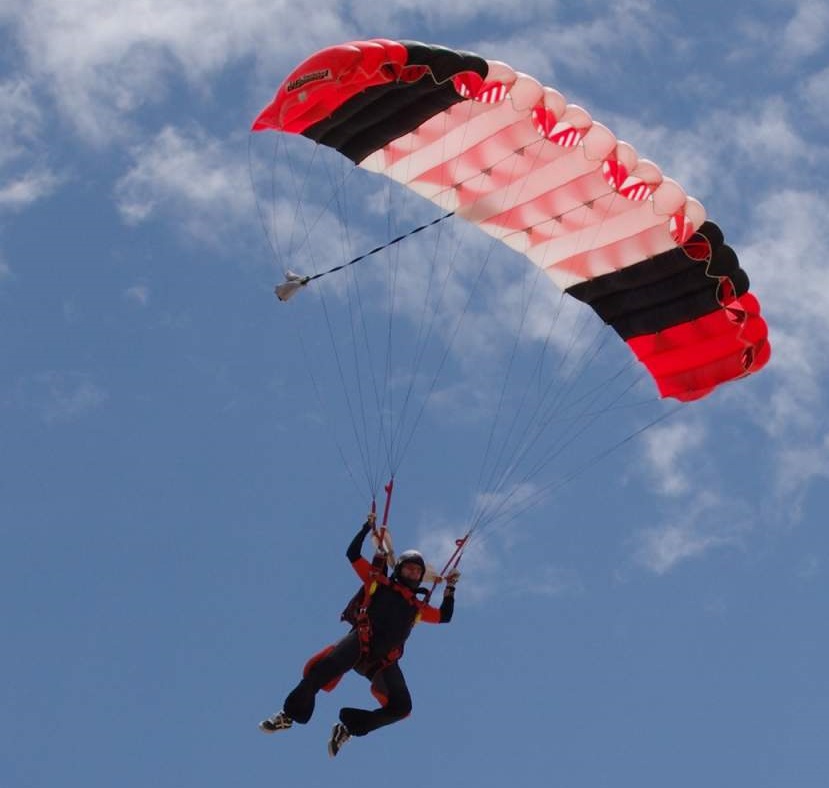Is there enough training/practice on how to PLF in the average AFF ground course?
By
Hawkins121, in Safety and Training
QuoteWhen I was trained on rounds back in the late 70's and early 80's we drilled PLF's like crazy.
Thats kinda the point. We do NOT jump rounds anymore.
Todays student canopies have a forward speed and approach. Sometimes not enabling the student to get into the best PLF position.
Drilling it into a students head, like he or she is in a military FJC, for hours and hours is stupid.
If they learn the reason and the dynamics of it during the training, and they exibit that they can do it correctly, then it's time to move on to other areas of the training program IMO.
Be safe
Ed
www.PrecisionSkydiving.com
QuoteIn many threads I see people mention that they broke their ankle, leg or foot landing. These are usually people with under 60 jumps or so.
9 times out of 10 a PLF can prevent breaking something. You might get up using a string of profanity but you will get up with your bones intact.
If it's only good for 9 of 10, there's your broken bone count!
The PLF training I got was well suited to my first landing when I flared 3 feet high. Minimal forward speed and I landing laughing.
But it's very different when you're coming in fast in no wind conditions and don't flare effectively to plane out and bleed off the speed.
Quote
QuoteWhen I was trained on rounds back in the late 70's and early 80's we drilled PLF's like crazy.
Thats kinda the point. We do NOT jump rounds anymore.
Todays student canopies have a forward speed and approach. Sometimes not enabling the student to get into the best PLF position.![[:/] [:/]](/uploads/emoticons/dry.png)
Drilling it into a students head, like he or she is in a military FJC, for hours and hours is stupid.
If they learn the reason and the dynamics of it during the training, and they exibit that they can do it correctly, then it's time to move on to other areas of the train program IMO.
Be safe
Ed
Be safe
Ed
Gotcha.. In that case I dont and wont feel bad about rolling my eyes when I read or hear about someone breaking their leg from flaring to high or to low. It is their responsibility to think about getting their feet and knees together.
QuoteIt is their responsibility to think about getting their feet and knees together.
Ultimately, from the time they leave the plane, the entire skydive is their responsibility, until they land back on earth, isn't it?
Be safe
Ed
www.PrecisionSkydiving.com
Quote
QuoteWhen I was trained on rounds back in the late 70's and early 80's we drilled PLF's like crazy.
Todays student canopies have a forward speed and approach. Sometimes not enabling the student to get into the best PLF position.![[:/] [:/]](/uploads/emoticons/dry.png)
I think its a little bit easier to get into a good plf position under a square simply because you are always going to be going forward like you just said... Much easier to set up a good roll. Instead of fighting oscilation while drifting to the left etc. But this is coming from my 30 square parachute jumps and 37 round parachute jumps of experience.. I could be completely wrong
QuoteI think its a little bit easier to get into a good plf position under a square simply because you are always going to be going forward like you just said... Much easier to set up a good roll.
So you think doing a PLF is easier facing straight forward, then at a slight angle such as 30-45 degrees? Hmmm....
Be safe
Ed
www.PrecisionSkydiving.com
Quote
QuoteI think its a little bit easier to get into a good plf position under a square simply because you are always going to be going forward like you just said... Much easier to set up a good roll.
So you think doing a PLF is easier facing straight forward, then at a slight angle such as 30-45 degrees? Hmmm....
Be safe
Ed
Its not always at a slight angle. When jumping rounds if the wind is really strong and you havent pulled your slips correctly you could still be rocking back and forth going at a 90 degree angle to the left or right... Under a square you'll be going straight ahead... It isnt terribly difficult to turn your body in that direction and i think the PLF is much cleaner having forward speed.
Fly your canopy all the way to the ground... you won't need to PLF except on _very_ rare occasions.
Front PLF's are easier and IMO safer than rears. Sides are easiest to perform, again just my opinion.
(My Opinion is based on 150 Military Static Line jumps and 20 years experience in the Airborne, including 4+ years as a Black Hat.)
So, start being safe, first!!!
QuoteThat is why you teach your students to rotate the hips in either direction 45 degrees, to make it a right front or left front.
Front PLF's are easier and IMO safer than rears. Sides are easiest to perform, again just my opinion.
(My Opinion is based on 150 Military Static Line jumps and 20 years experience in the Airborne, including 4+ years as a Black Hat.)
lol then i'd say its a good opinion!
QuoteThat is why you teach your students to rotate the hips in either direction 45 degrees, to make it a right front or left front.
True. Though we do teach a slight rotation of the hips for proper PLF, they sometimes forget that part also.
QuoteSides are easiest to perform, again just my opinion.
Depends on the landing area the students have, I've seen some pretty shitty ones.
Be safe
Ed
www.PrecisionSkydiving.com
So, start being safe, first!!!
QuoteIwas refering to the "side" PLF.
Got it, fixed.
Be safe
Ed
www.PrecisionSkydiving.com
Shark 0
QuoteBecause I am retarded I had more than one occasion where I flared to high or to low and had to PLF.
You can spend all day teaching PLFs and the dive flow. It is not always feasible.
More emphasis on canopy control would, most likely, cure one's need to PLF. You should, however, be prepared to PLF on every skydive.
councilman24 36
Like Tom I've walked away from some nasty screw ups by dropping into a PLF automatically.
Terry Urban
D-8631
FAA DPRE
Quotetraining included doing PLF's backwards off the roof of a pickup.
Glad it was you and not me.......
Then again, in todays litigious society, people might sue before even making their jump......
Be safe
Ed
www.PrecisionSkydiving.com
wmw999 2,116
I'm sure I could have exhibited more skill. However, I found that getting a different canopy after 150 or so jumps was far more comfortable. But I still am ready to PLF when needed.
I have about 500 round jumps, and was one of those instructors who drummed it into students' heads in the early 80's; I've done my share
Wendy W.
Sorry, what ?
So, start being safe, first!!!
So on about my fourth jump on my new sport main, I flared just that bit too hard, too late, and executed what was apparently a textbook PLF without even noticing I did it. Got mud on my lower leg, arse and in my container-top up the same side to prove it too.
Muscle memory rocks. Make students really gain it for the PLF, we will need it.
Thanks Luci
"I'll tell you how all skydivers are judged, . They are judged by the laws of physics." - kkeenan
"You jump out, pull the string and either live or die. What's there to be good at?







That is true, but I think in general better training would make the PLF more of an automatic response.
When I was trained on rounds back in the late 70's and early 80's we drilled PLF's like crazy. It became an automatic response. I've used PLF's several times since then on modern squares when I knew the landing was going to hell, and the PLF's have saved me. I remain thankful to my early instructors for focusing on that skill.
Like the original poster on this thread, I'm concerned that we don't spend enough time on PLF's. It's not really such a big deal for most student jumps, but when the crap is hitting the fan a student should be able to pull a PLF out of his butt, and too often they can't do that.
My sense is that when a landing is about to go bad our students dig into their memory and training, and then lift their legs as they were taught to do for the first tandem. Better PLF training would be an improvement.
With all that said, the level of training varies from DZ to DZ, and among instructors.
.
Instructor Emeritus
Comm Pilot MSEL,G
Author: JUMP! Skydiving Made Fun and Easy
Share this post
Link to post
Share on other sites